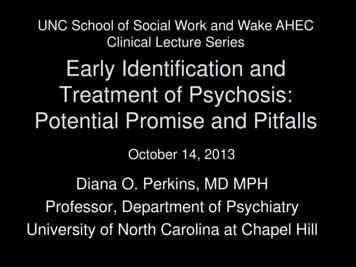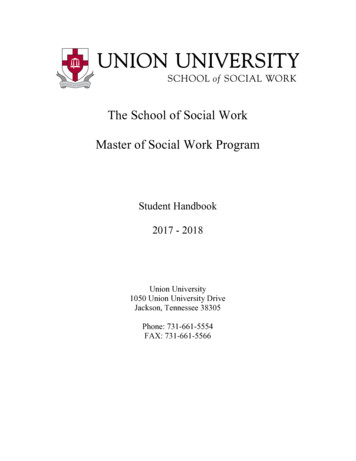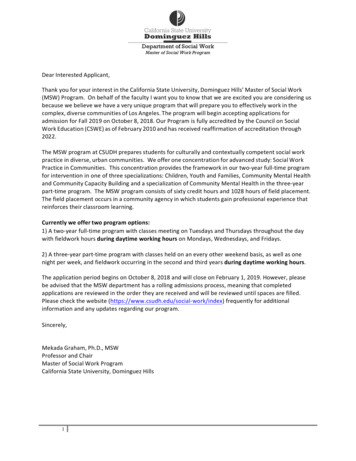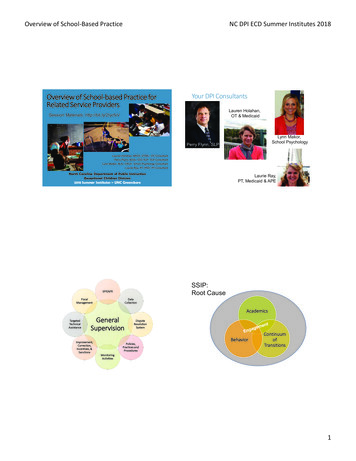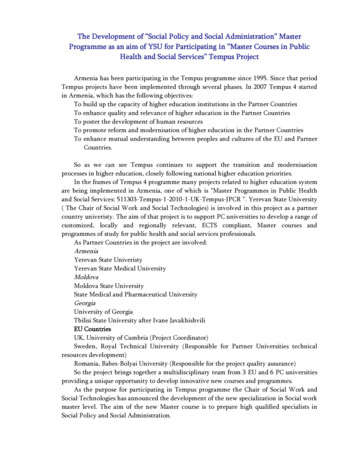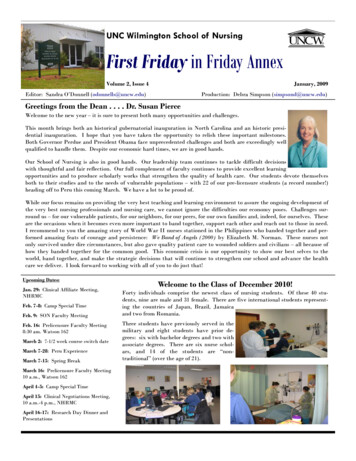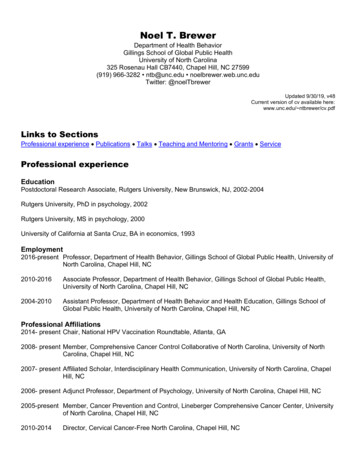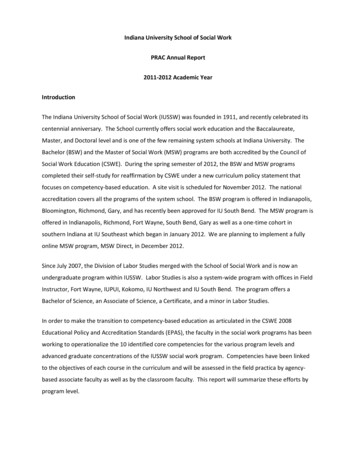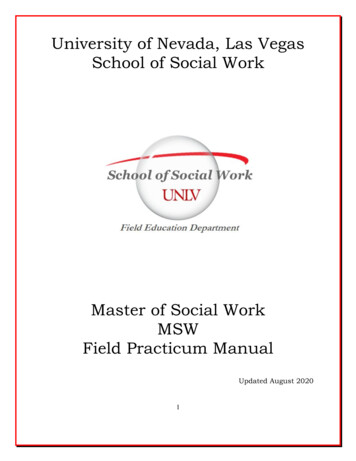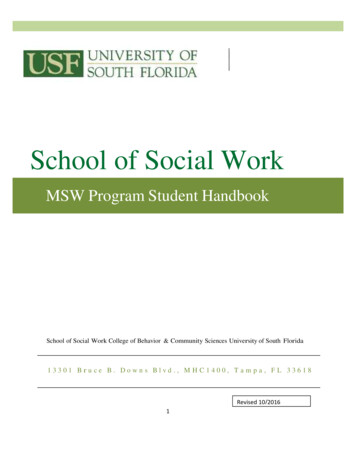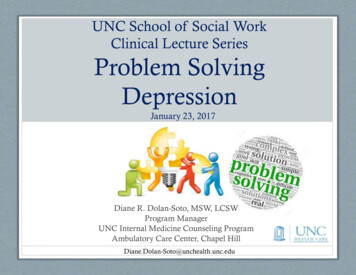
Transcription
UNC School of Social WorkClinical Lecture SeriesProblem SolvingDepressionJanuary 23, 2017Diane R. Dolan-Soto, MSW, LCSWProgram ManagerUNC Internal Medicine Counseling ProgramAmbulatory Care Center, Chapel HillDiane.Dolan-Soto@unchealth.unc.edu
Agenda Information on Depression and Reasons for Treatment Evidenced Based Model for Depression Care Case Examples of Getting Better Through Problem Solving Build Knowledge and Skills to Fight Depression Steps to Move Through and Beyond Depression with ProblemSolving Additional Tool: Unhelpful Thinking Styles and Depression Appendices: Treatment Considerations Behavioral Assessment Educational Aspects Mnemonics for Depression
Objectives Learn key aspects of a really successful approach todepression treatment. Learn steps to problem solving to reduce depression Come away from this training with information that youcan use to incorporate in your practice to improvedepression care and patient outcomes.
Why Treat Depression in aPrimary Care Setting? Depression is a medical illness 5-10% of patients have MDDs. 7-16% lifetime risk in U.S. adults 10% - 20% of adults visit their doctor during a depressive or anxious episode Over 50% suffer from comorbid depressive or anxiety disorder Comorbidity substantially increases medical utilization, is associated with greaterchronicity, slower recovery and greater psychosocial disability 4th leading contributor to disability, expected to be 2nd by 2020 People with diabetes, coronary artery disease, stroke, obesity, and HIV havea two-fold risk of depression compared to the general population One episode of depression increases likelihood of future episodes Patients can have increased pain related to depression Depression increases emotional and physical sensitivity
Treatment Works! 80% of those who get treatment improve! Only 50% of people with depression seek treatmentEffective treatment reduces symptomsand improves quality of life 46% of adults improve with medication,48% improve with counselingProviding both doubles the effectiveness of care
Evidenced Based Depression Care Structured and integrated care in a primary care setting Uses trained physicians and counselorsUses algorithms to guide treatmentRegular monitoring to assess and facilitate treatment progressBuilds on existing patient trust and access with provider/clinicExample: IMPACT – Randomized Controlled Trial For information on IMPACT: -access-collaborative-treatment Past Usual Care Seen by a doctor, usually not trained in depression care See a counselor in another setting for long term talk therapy May or may not see a psychiatrist for medication
IMPACT Treatment and Results!Study year:Doubled the effectiveness of usual care– JAMA 2002; 288:2836-2845Patients experienced better physical function– Callahan et al, JAGS2005Care was shown to benefit diverse populations– Arean et al. Medical Care 2005Beyond study:Effects persisted one year after IMPACT– Hunkeler, et al 2004 – unpublished dataMore depression-free days; 372 for IMPACT approach vs 265for usual care patients – Hunkeler et al, under review (DFD calculation adapted from Lave et al 1998)As depression decreased for 1,001 arthritis patients, so did painand pain interference– Lin et al, JAMA 2003
PHQ-9to Identify DepressionPatient Health Questionnaire-9 Validated screenerSensitivity 91% for MDD,Specificity 89% for MDD 9 questions 9 symptoms ofdepression 5 or more symptoms for 2 weekscould be depression Symptoms for 2 months could bemajor depression Rule outs Medical conditions, medicinesOther issues that could look likedepression: grief, illness/pain, somesituational stressors, anxiety, etc.“Closest thing we’ve got to takingtemperature for mood”
PHQ-9, Scoringand Treatment Response PHQ-9 scoring, treatment (Tx) and follow up 9 No or mild depression -- No TxScreen in 1 yr or as needed 10-14 Moderate depression -- Treatment NeededRTC in 12 wks Education, Recommend Problem Solving, Activation, Rx?, Watchful monitoring 15 Severe depression-- Treatment NeededRTC in 4 wks Recommend Rx! and Problem Solving, Activation, Regular Monitoring Clinically significant improvement drop of 5 points Remission of depression is a drop of PHQ by 50% No depression 5 points
Problem Solving Treatment*Behavioral health aspect of IMPACT:Three components of fighting depression1. Focus on the Present2. Pleasant Activity3. Physical ActivityTeaches a structured approach to dealing with issuesIncreases the ability to define problems and set realistic goalsIncreases understanding of importance of link between effort and mood*From Dr. Jürgen Unützer’s IMPACT Model
Getting BetterCase Examples ofProblem Solving Depression
*SBefore Referral: A 53 year old man with heartdisease. Severely depressed related tohealth issues and limited mobility poststroke. Felt like he coped well with stroke,but felt like a burden to his family. Doctorthought he’d benefit from activatingantidepressant such as bupropion, howeverMr. S preferred to try counseling andincreasing his activity first. At Assessment: Strained relationship withhis wife and family. Doing very little forhimself. Most of his needs met throughcare from others. He was about to face the‘donut hole’ with Medicare so he couldonly come for 3 to 4 visits includingassessment. PHQ9 15 Heart disease, othermedical issues, recent stroke Family help with nearly allaspects of care Alienating supports Spending time alone:watching TV, crying orsleepingNot patient’s real initial. Elements of example have been changed to protect confidentiality.
*SBefore PHQ9 15 Heart disease, other medicalissues, recent stroke After PHQ9 7 (3 sess phone 1x)Family help with nearly allaspects of care Engaging in self-care efforts Alienating supports Improving relationships;reconnected to social andfaith support network Spending time alone: watchingTV, crying or sleeping Discovery of new measuresof self-worthNot patient’s real initial. Elements of example have been changed to protect confidentiality.
*KBefore Referral: A 43 year old woman.Uncontrolled Type II Diabetes.Care for developmentally disabled18 year old son and a 16 year oldson. At Assessment: Making efforts totake care of sons. Constant contactand requests for help from hermother. Little time with husbandcausing arguments. No time spenton self-care. Feels guilty abouttaking time for herself. PHQ9 18 Uncontrolled diabetes, nottaking Rxs regularly. Notphysically active. Not sleepingwell, over eating. Focus on others to exclusionof self-careNot patient’s real initial. Elements of example have been changed to protect confidentiality.
*KBeforeAfter PHQ9 18 PHQ9 5 (at 11 mo, sess 12 of 12) Uncontrolled diabetes, nottaking Rxs regularly. Notphysically active. Not sleepingwell, over eating. Taking Rxs regularly--Established healthy sleep hygieneand bedtime routine-Use of Rxs, PT, Mind Body Skillsand regular walking. Better foodportions. Focus on others to exclusionof self-care Set healthy boundaries. Improvedrelationships. Getting out,socializing. Surprise benefit re: diabetesNot patient’s real initial. Elements of example have been changed to protect confidentiality.
Behavioral Approach:Build Knowledge andSkills to Fight DepressionSharing What I’ve Learned for Effective Depression Care
Overview ofBehavioralDepression CareAssessment Visit Assess Full psychosocial diagnosticRiskPHQ9Mood symptoms emphasis on functionalityand effortsAnd Educate! On Depression and PHQ9 Treatment options Link impact of effort to mood 1st visit: assessment,diagnosis, education asappropriate, and treatmentplanning. Format to theright:Introduce Behavioral Approach 3 Components to fight depression Self-report measure - “If we’re doing the rightthings the PHQ9 score will be going down. If it’snot, it means you and I need to change the goals,you and your doctor need to make changes, or wemade need to involve a psychiatrist or othersupports or treatments.” Set Goal for Treatment and ReturnAppointment for First Counseling Visit
Share the Diagnosis! A diagnosis is based on symptoms. Helpful for billing anda focus on what we’re going to work on. “A diagnosis is more like a street sign, it’s where you are,not who you are.”-- Diane R. Dolan-Soto, LCSW Reduce stigma Build trust, rapport and engagement, and understanding ofwhat they need to be working on
“Depression is like Pneumonia”PneumoniaDepression 1 episode makes you moresusceptible to getting it in thefuture. 1 episode makes you moresusceptible to getting it inthe future. Medication for about a month May take both medication, Work with your doctor andmake efforts to get better Can take 1 to 4 months to getbetterlike with severedepression, and effort toget better. Life cycle is 9 to 12 months
Depression Downward SpiralDon’t feel goodFeel overwhelmed. Do less.Feel worse. Less active.Everything feels like ‘too much to do’.Stop doing pleasant activities.
Reverse the Spiral!!Do some pleasant activity.Remind yourself, or learn, how to have funDo some physicalactivity, as ableDo something!Focus on the presentand what’s withinyour control
Steps toMove Throughand Beyond DepressionOrient to TreatmentKeys for Moving ForwardHow To Define The Problem and Set a GoalHow to Figure Out SolutionsEvaluate Pros and ConsHow To Do More Successful Goal SettingMove Beyond Depression and Prevent Relapse
Overview ofBehavioralDepression Care First Visit: Orient to Treatment. Ongoing: Check-In PHQ9 Rate mood on scale of 0-10 Rate satisfaction with effort 0-10 Review / Assess Risk Functional changes: medication sleeping,eating, substance use, etc. Efforts, progress, challenges related to previousvisit’s goalsReturn Visit Aid treatment change, linkage, etc. Link impact of effort to mood Problem Solving Focus Presenting issue or problem patient wants toaddress Return sessions followformat to the right:Set Goals and Return Timeframe Identify Solutions – set manageable goals Pleasant and Physical Activity goals Continue to Educate and Encourage!!
Keys to Move Forward1.Focus on the present and what’s within your control“What’s the smallest thing you can do to feel good for the effort?”-- Joseph B. Quinn, MSW1.Pleasant Activity – At least 2x weekFeel better while doing, “Not a should”2.Physical activity – 3x week ‘as doable’For providers: Note emphasis on CBT and Solution Focused aspectsGoal Setting Initial Aims Identify easiest goal(s) that will result in a successful outcomeBUILD HOPE and CONFIDENCEIMPACT Problem Solving Components in blue
Get a Baseline Rate Mood 1 to 10 with 10 being the best – Initially “Don’t make it pretty!” The more realistic the rating, the more your person will trust when thenumbers improve Quantify how your person is feeling now Rate Satisfaction with Effort in taking care of mood 1 to 10 with 10 being the best Quantify how satisfied your person is and howcomfortable/uncomfortable they are with current situation; alsoidentifies motivation for change
How To Define The Problem“Depressed thinking is like having blinders on.” –only see the negative,everything looks too difficult. Identify the problem of the moment! ‘My home is a disaster.’ Set an overarching goal – What do you want to happen? ‘I want to reclaim my home.’
Mail and other papers piling upReduce backlog and create some orderSort papers intopiles (maybe w/ afriend)I’d feel more organizedPull out and shredjunk mail!I need to do thisGo thru and pullout any billsPut file for bills,shredder & recyclingbag near door & sortwhen it comes inI’d stop worrying that I missedsomething. I’d feel relieved.It would make things easier, preventfuture pile up of papers.
Mail and other papers piling upReduce backlog and create some orderSort papers intopiles (maybe w/ afriend)I’d feel more organizedPull out and shredjunk mail!I need to do thisGo thru and pullout any billsPut file for bills,shredder & recyclingbag near door & sortwhen it comes inI’d stop worrying that I missedsomething. I’d feel relieved.It would make things easier, preventfuture pile up of papers.
How to Figure Out Solutions Look for possible solutions toward one aspect of the goal. Think small!! What’s within your control? Where would you start? Who or what would be needed? What could you do in 5 to 20 minutes? Identify at least 2 to 5 possible solutions It helps to recognize there are options to “open the blinders” This may sound simplistic. For your patient, it’s not! You may need to reassure your client/patient: “If this was easy youwould’ve already figured it out.”
Mail and other papers piling upReduce backlog and create some orderSort papers intopiles (maybe w/ afriend)I’d feel more organizedPull out and shredjunk mail!I need to do thisGo thru and pullout any billsPut file for bills,shredder & recyclingbag near door & sortwhen it comes inI’d stop worrying that I missedsomething. I’d feel relieved.It would make things easier, preventfuture pile up of papers.
Mail and other papers piling upReduce backlog and create some orderSort papers intopiles (maybe w/ afriend)I’d feel more organizedPull out and shredjunk mail!I need to do thisGo thru and pullout any billsPut file for bills,shredder & recyclingbag near door & sortwhen it comes inI’d stop worrying that I missedsomething. I’d feel relieved.It would make things easier, preventfuture pile up of papers.
Identify the ProsRepeat back each solution and ask: “What makes this a good choice for you?” Helps literally with structuring their thought process Look for “me” and “I” based answers. “It would make me feelgood.” “I like ” “I want ” These are usually the most powerful motivators.Often ‘shoulds’ are the first response Try to avoid shoulds. More likely to be difficult. May compound feelingsof hopelessness. Less likely to motivate.
Mail and other papers piling upReduce backlog and create some orderSort papers intopiles (maybe w/ afriend)Pull out and shredjunk mail!Go thru and pullout any billsPut file for bills,shredder & recyclingbag near door & sortwhen it comes in
Mail and other papers piling upReduce backlog and create some orderSort papers intopiles (maybe w/ afriend)I’d feel more organizedPull out and shredjunk mail!I need to do thisGo thru and pullout any billsPut file for bills,shredder & recyclingbag near door & sortwhen it comes inI’d stop worrying that I missedsomething. I’d feel relieved.It would make things easier, preventfuture pile up of papers.
Identify the ConsState the solution, the ‘pro’ and thenhelp your client evaluate the cons foreach solution.Cons (-)A Little Medium A LotEffort[ ][ ][ ]Time[ ][ ][ ]Money[ ][ ][ ]Emotional Impact[ ][ ][ ]Involving Others[ ][ ][ ]
Mail and other papers piling upReduce backlog and create some orderSort papers intopiles (maybe w/ afriend)I’d feel more organizedPull out and shredjunk mail!I need to do thisGo thru and pullout any billsPut file for bills,shredder & recyclingbag near door & sortwhen it comes inI’d stop worrying that I missedsomething. I’d feel relieved.It would make things easier, preventfuture pile up of papers.
Mail and other papers piling upReduce backlog and create some orderSort papers intopiles (maybe w/ afriend)Pull out and shredjunk mail!Go thru and pullout any billsPut file for bills,shredder & recyclingbag near door & sortwhen it comes inI’d feel more organizedI need to do thisI’d stop worrying that I missedsomething. I’d feel relieved.It would make things easier, preventfuture pile up of papers.[ ][ ][o][ ][ ][ ][ ][ ][ ][x][ ][ ][o][ ][o][ ][ ][ ][x][ ][x][x][ ][ ][ ][x][x][o][x][o][[[[[[[[[[[ ][ ][o][ ][o][ ][x][ ][x][ ][[[[[[[[[[]]]]]]]]]]]]]]][x][x][ ][x][ ]]]]]][x][ ][ ][ ][ ][[[[[]]]]]
Mail and other papers piling upReduce backlog and create some orderSort papers intopiles (maybe w/ afriend)Pull out and shredjunk mail!Go thru and pullout any billsPut file for bills,shredder & recyclingbag near door & sortwhen it comes inI’d feel more organizedI need to do thisI’d stop worrying that I missedsomething. I’d feel relieved.It would make things easier, preventfuture pile up of papers.[ ][ ][o][ ][ ][ ][ ][ ][ ][x][ ][ ][o][ ][o][ ][ ][ ][x][ ][x][x][ ][ ][ ][x][x][o][x][o][[[[[[[[[[[ ][ ][o][ ][o][ ][x][ ][x][ ][[[[[[[[[[]]]]]]]]]]]]]]][x][x][ ][x][ ]]]]]][x][ ][ ][ ][ ][[[[[]]]]]
Physical and Pleasant Activity Physical Activity Make the goal concrete: eg. walk 3 times a week for 15-20 minutes Be creative! It all counts! Pleasant Activity Feel good while you’re doing, lose track of time.Music, art, crafts, games, social, etc. Passive activities can support background worrying, don’t usually improvemood and functioning. Too much TV/computer can contribute to depression – news, crime shows,negative comparison to what others are doing/have If they don’t have what they need but they want to get it, that may bethe first goal. Every step takes effort, a precious commodity with depression
How To Do More SuccessfulGoal Setting Assess ability to actually accomplish the goal! ASK: “On a scale of 1-10 how likely are you to be ableto do with 10 being the most likely?” Rated 1-7 Rework the goal “What would it take to make it an 8?” Rated 8 or above most likely success! Make an appointment! Increases the likelihood for a successful goal. What’s the best day and time What else will help make the goal possible
Goal SheetGoals until next visit:Today we discussed your goal of: “Reduce backlog of papers and create someorder”Today you set step(s) below for yourself to work towards this goal.Take 20 minutes Saturday after lunch to go through and pull out any bills,consider listening to favorite upbeat CDPleasant Activity: Call my friend and / or go to lunch togetherPhysical Activity: Walk at home or at work during lunch for 10-15 minutes2-3 times a week.Problem Solving weekly goal reminder:1. Focus on the present and what’s within your controlTasks and problems - pick the smallest thing you can do that will make you feel good for the effort.Focus only on what’s within your control2. Pleasant activity 1-2 times a week3. Physical activity 3 times a week, within what’s physically comfortable
To Keep It Moving ForwardSteps to Move Through and Beyond Depression Review: “Tell me what you’ve been doing to take care of yourmood.” “Focus on what someone does, not what they haven’t done” If you set goals, review them!! Link impact of effort to mood Continue to help clients/patients to:Monitor/rate. Share PHQ and treatment progressWith realistic expectations, judgmentsLearn to pace their effortsRecognize and sustain their progressDiscuss what relapse would look like anddiscuss how to prevent relapse Determine next steps with your client
Unhelpful Thinking StylesAdding a Powerful Tool to Your Toolkit
“Anything look familiar?”Identify which unhelpfulthinking styles are used
Work onUnhelpful Thinking Styles Initial thought – Immediate real concern or risk? Address!! If no immediate risk, then assess for unhelpful thinking Evidence for thought? Evidence against thought? For an unhelpful thought, develop a new, revised, morerealistic and balanced thought based on the evidence Practice work with unhelpful thinking styles Notice. Kindly interrupt. [Over time learn to] Change. Repeat effort. Change comes with practice. Work to get rid of the ANTs! (Automatic Negative Thoughts)
Problem SolvingDepressionAdding Powerful Skills toSuccessfully Fight DepressionDiane.Dolan-Soto@unchealth.unc.edu
Acknowledgements IMPACT Improving Mood Promoting Access to Collaborative treatment – evidenced baseddepression treatment for primary care. Problem Solving Treatment. Dr. JürgenUnützer. -access-collaborative-treatm
UNC School of Social Work Clinical Lecture Series Problem Solving Depression Diane R. Dolan-Soto, MSW, LCSW Program Manager UNC Internal Medicine Counseling Program Ambulatory Care Center, Chapel Hill Diane.Dolan
